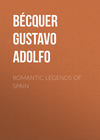Buch lesen: «Spanish Highways and Byways», Seite 23
Delighted boys from a peasant camp beyond the walls ran up to jeer at our predicament. Our coachman, reverting to his dolorous chant, appealed to all the saints. The top fares shrilled in on the chorus; the Spanish gentlemen lighted cigarettes, and after some twenty minutes of dramatic altercation, a soldier sprang on our top step and mounted guard, while the coach rattled through the gates and on to the aduana. Here we were deposited, bag and baggage, on the pavement, and a drowsy, half-clad old dignitary was brought forth to look at us. The coachman, all his social graces restored, imaginatively presented the three Anglo-Saxons as a French party travelling for pleasure. "But what am I to do with them?" groaned the dignitary, and went back to bed. An appalling group of serenos, in slouch hats and long black capes, with lanterns and with staffs topped by steel axes, escorted us into a sort of luggage room, and told us to sit down on benches. We sat on them for half an hour, which seemed to satisfy the ends of justice, for then the serenos gave place to porters, who said they would bring us our property, which nobody had examined or noticed in the slightest, after daybreak, and would now show us the way to our hotel. Our farewell to the coachman, who came beaming up to shake hands and receive thanks, was cold.
We had engaged rooms by letter a week in advance, but they had been surrendered to earlier arrivals, and we were conducted to a private house next door to the hotel. After the delays incident to waking an entire family, we were taken into a large, untidy room, furnished with dining table, sewing machine, and a half dozen decrepit chairs. There was no water and no sign of toilet apparatus, but in an adjoining dark closet were two narrow cots, from which the four daughters of the house had just been routed. Of those beds which these sleepy children were then, with unruffled sweetness and cheeriness, making ready for us, the less said the better. Our indoor hours in Compostela, an incessant battle against dirt, bad smells, and a most instructive variety of vermin, were a penance that must have met all pilgrim requirements. And yet these people spared no pains to make us comfortable, so far as they understood comfort. At our slightest call, were it only for a match, in would troop the mother, four daughters, maid, dog, and cat, with any of the neighbors who might be visiting, all eager to be of service. The girls were little models of sunny courtesy, and would have been as pretty of face as they were charming in manner, had not skin diseases and eye diseases told the tale of the hideously unsanitary conditions in which their young lives had been passed.
But we had come to the festival of Santiago, and it was worth its price.
XXV
THE BUILDING OF A SHRINE
(A historical chapter, which should be skipped.)
That most Spanish of Spaniards, Alarcón, is pleased in one of his roguish sketches to depict the waywardness of a certain poetaster. "Alonso Alonso was happy because he was thinking of many sad things, – of the past centuries, vanished like smoke, … of the little span of life and of the absurdities with which it is filled, of the folly of wisdom, of the nothingness of ambition, of all this comedy, in short, which is played upon the earth."
Alonso Alonso would be in his very element in Santiago de Compostela. The "unsubstantial pageant faded" of the mediæval world is more than memory there. It is a ghost that walks at certain seasons, notably from the twentieth to the twenty-eighth of July. The story of the birth, growth, and passing of that once so potent shrine, the Jerusalem of the West, is too significant for oblivion.
The corner-stone of the strange history is priestly legend. The Apostle James the Greater, so runs the tale, after preaching in Damascus and along the Mediterranean coast, came in a Greek ship to Galicia, then under Roman rule, and proclaimed the gospel in its capital city, Iria-Flavia. Here the Virgin appeared to him, veiled, like the mother of Æneas, in a cloud, and bade him build a church. This he did, putting a bishop in charge, and then pursued his mission, not only in the remote parts of Galicia, but in Aragon, Castile, and Andalusia. At Saragossa the Virgin again flashed upon his sight. She was poised, this time, on a marble pillar, which she left behind her to become, what it is to-day, the most sacred object in all Spain. A chip of this columna immobilis is one of the treasures of Toledo. The cathedral of the Virgen del Pilar, – affectionately known as Pilarica, – which James then founded at Saragossa, is still a popular goal of pilgrimage, the marble of the holy column being hollowed, at one unshielded spot, by countless millions of kisses. The Apostle, on his return to Jerusalem after seven years in Spain, was beheaded by Herod. Loyal disciples recovered the body and set sail with it for the Spanish coast. Off Portugal occurred the pointless "miracle of the shells." A gentleman was riding on the shore, when all at once his horse, refusing to obey the bit, leapt into the sea, walking on the crests of the waves toward the boat. Steed and rider suddenly sank, but promptly rose again, all crusted over with shells, which have been ever since regarded as the emblem of St. James in particular, and of pilgrim folk in general.
"How should I your true love know
From another one?
By his cockle hat and staff
And his sandal shoon."
The Santiago "cockle," which thus, as a general pilgrim symbol, outstripped the keys of Rome and the cross of Jerusalem, is otherwise accounted for by a story that the body of St. James was borne overseas to Galicia in a shell of miraculous size, but this is not the version that was told us at the shrine.
The two disciples, Theodore and Athanasius, temporarily interred their master in Padron, two leagues from Iria, until they should have obtained permission from the Roman dame who governed that region to allow St. James the choice of a resting-place. Her pagan heart was moved to graciousness, and she lent the disciples an ox-cart, in which they placed the body, leaving the beasts free to take the Apostle's course. It is hardly miraculous that, under the circumstances, Lady Lupa's oxen plodded straight back to Iria and came to a stop before her summer villa. Since this was so clearly indicated as the choice of the saint, she could do no less than put her house at his disposal. In the villa was a chapel to the war-god Janus, but when the body of Santiago was brought within the doors, this heathen image fell with a crash into a hundred fragments. Here the saint abode, guarded by his faithful disciples, until, in process of time, they slept beside him. The villa had been transformed into a little church, so little that, when the Imperial persecutions stormed over the Spanish provinces, the worshippers hid it under heaps of turf and tangles of brier bushes. Those early Christians of Iria were slain or scattered, and the burial place of St. James was forgotten of all the world.
In the seventh century, a rumor went abroad that the Apostle James had preached the gospel in Spain. The legend grew until, in the year 813, a Galician anchorite beheld from the mouth of his cavern a brilliant star, which shone persistently above a certain bramble-wood in the outskirts of Iria. Moving lights, as of processional tapers, twinkled through the matted screen of shrubbery, and solemn chants arose from the very heart of the boscage. Word of this mystery came to the bishop, who saw with his own eyes "the glow of many candles through the shadows of the night." After three days of fasting, he led all the villagers in procession to the thicket which had grown up, a protecting hedge, about the ruins of the holy house. The three graves were found intact, and on opening the chief of these the bishop looked upon the body of St. James, as was proven not only by severed head and pilgrim staff, but by a Latin scroll. The swiftest horsemen of Galicia bore the glorious tidings to the court of the king, that most Christian monarch, Alfonso II, "very Catholic, a great almsgiver, defender of the Faith." So loved of heaven was this pious king, that once, when he had collected a treasure of gold and precious stones for the making of a cross, two angels, disguised as pilgrims, undertook the work. When, after a few hours, Alfonso came softly to the forge to make sure of their honesty and skill, no artisans were there, but from an exquisitely fashioned cross streamed a celestial glory. So devout a king, on hearing the great tidings from Galicia, lost no time in despatching couriers to his bishops and grandees, and all the pomp and pride of Spain, headed by majesty itself, flocked to the far-off hamlet beyond the Asturian mountains to adore the relics of Santiago.
Now began grand doings in Iria, known henceforth as the Field of the Star, Campus Stellæ, or Compostela. Alfonso had a church of stone and clay built above the sepulchre, and endowed it with an estate of three square miles. The Pope announced the discovery to Christendom. A community of twelve monks, with a presiding abbot, was installed at Compostela to say masses before the shrine. For these beginnings of homage the Apostle made a munificent return. A wild people, living in a wild land at a wild time, these Spaniards of the Middle Ages were shaped and swayed by two sovereign impulses, piety and patriotism. These two were practically one, for patriotism meant the expulsion of the Moor, and piety, Cross above Koran. It was a life-and-death struggle. The dispossessed Christians, beaten back from Andalusia and Castile to the fastnesses of the northern mountains, were fighting against fearful odds. They felt sore need of a leader, for although, when their ranks were wavering, the Virgin had sometimes appeared to cheer them on, hers, after all, was but a woman's arm. It was in the battle of Clavijo, 846, that Santiago first flashed into view, an invincible champion of the cross.
Rameiro, successor to Alfonso II, had taken the field against the terrible Abderrahman of Cordova, who had already overrun Valencia and Barcelona and was demanding from Galicia a yearly tribute of one hundred maidens. This exceedingly Moorish tax, which now amuses Madrid as a rattling farce in the summer theatre of the Buen Retiro, was no jesting matter then. Not only the most famous warriors of the realm, Bernardo del Carpio in their van, but shepherds and ploughmen, priests, monks, even bishops, flocked to the royal standard.
"A cry went through the mountains when the proud Moor drew near,
And trooping to Rameiro came every Christian spear;
The blesséd Saint Iago, they called upon his name: —
That day began our freedom, and wiped away our shame."
The hosts of Cross and Crescent met in battle-shock near Logroño. Only nightfall saved the Christians from utter rout, but in those dark hours of their respite the apparition of Santiago bent above their sleeping king. "Fear not, Rameiro," said the august lips. "The enemy, master of the field, hems you in on every side, but God fights in your ranks." At sunrise, in the very moment when the Moslem host was bowed in prayer, the Christians, scandalized at the spectacle, charged in orthodox fury. Their onset was led by an unknown knight, gleaming in splendid panoply of war. Far in advance, his left hand waving a snowy banner stamped with a crimson cross, he spurred his fierce white horse full on the infidel army. His brandished sword "hurled lightning against the half-moon." At his every sweeping stroke, turbaned heads rolled off by scores to be trampled, as turbaned heads deserve, under the hoofs of that snorting steed. The Son of Thunder had found his function, which was nothing less than to inspirit the Reconquest. Henceforth he could always be counted on to lead a desperate assault, and "Santiago y Cierra España!" was the battle-cry of every hard-fought field. So late as 1212, at the crucial contest of Las Navas de Tolosa, the "Captain of the Spaniards" saved the day.
Whatever may be thought of such bloody prowess on the part of Christ's disciple, the fisherman of Galilee, he could not have taken, in that stormy age, a surer course to make himself respected. All Europe sprang to do honor to a saint who could fight like that. Charlemagne, guided by the Milky Way, visited the shrine, if the famous old Codex Calixtinus may be believed, with its convincing print of the Apostle sitting upright in his coffin and pointing the great Karl to the starry trail. In process of time the Gran Capitan came bustling from Granada. The king of Jerusalem did not find the road too long, nor did the Pope of Rome count it too arduous. England sent her first royal Edward, and France more than one royal Louis. Counts and dukes, lords and barons, rode hundreds of miles to Compostela, at the head of feudal bands which sometimes clashed by the way. Saints of every clime and temper made the glorious pilgrimage, – Gregory, Bridget, Bernard, Francis of Assisi. To the shrine of St. James came the Cid in radiant youth to keep the vigil of arms and receive the honors of knighthood, and again, mounted on his peerless Bavieca, to give thanks for victory over the five Moorish kings. It was on this second journey that he succored the leper, inviting him, with heroic disdain of hygiene, to be his bedfellow "in a great couch with linen very clean and costly."
Even in the ninth century such multitudes visited the sepulchre that a society of hidalgos was formed to guard the pilgrims from bandits along that savage route, serve them as money-changers in Compostela, and in all possible ways protect them from robbery and ill-usage. This brotherhood gave birth to the famous Order of Santiago, whose two vows were to defend the pilgrims and fight the Mussulmans. These red-cross knights were as devout as they were valiant, "lambs at the sound of the church-bells and lions at the call of the trumpet." Kings and popes gave liberally to aid their work. Roads were cut through Spain and France, even Italy and Germany, "to Santiago." Forests were cleared, morasses drained, bridges built, and rest-houses instituted, as San Marcos at Leon and the celebrated hostelry of Roncesvalles. Compostela had become a populous city, but a city of inns, hospitals, and all variety of conventual and religious establishments. Even to-day it can count nearly three hundred altars. In the ninth century the modest church of Alfonso II was replaced by an ornate edifice rich in treasures, but in the gloomy tenth century, when Christian energies were arrested by the dread expectation of the end of the world, the Moors overran Galicia and laid the holy city waste. The Moslem general, Almanzor, had meant to shatter the urn of Santiago, but when he entered Compostela with his triumphant troops, he found only one defender there, an aged monk sitting silent on the Apostle's tomb. The magnanimous Moor did not molest him, nor the ashes his feebleness guarded better than strength, but took abundant booty. When Almanzor marched to the south again, four thousand Galician captives bore on their shoulders the treasures of the Apostle, even the church-bells and sculptured doors, to adorn the mosque of Cordova. The fresh courage of the eleventh century began the great Romanesque cathedral of Santiago. Donations poured in from all over Europe. Pilgrims came bowed under the weight of marble and granite blocks for the fabric. Young and old, men and women, beggars and peasants, princes and prelates, had a hand in the building, cutting short their prayers to mix mortar and hew stone. Artists from far-off lands, who had come on pilgrimage, lingered for years, often for lifetimes, in Compostela, making beautiful the dwelling of the saint.
The great epoch of Santiago was the twelfth century, when there succeeded to the bishopric the able and ambitious Diego Gelmirez, who resolved that Compostela should be recognized as the religious centre of Spain, and be joined with Jerusalem and Rome in a trinity of the supreme shrines of Christendom. He was a man of masterly resource, persistence, pluck. Not too scrupulous for success, he found all means good that made toward the accomplishment of his one splendid dream. The clergy of Santiago, who had hitherto borne but dubious repute, he subjected to instruction and to discipline, calling learned priests from France to tutor them, and sending his own, as they developed promise, to sojourn in foreign monasteries. He zealously promoted the work on the cathedral, rearing arches proud as his aspiration, and watch-towers strong as his will. He invested the sacred ceremonies, especially the ecclesiastical processions, with extraordinary pomp, so that the figure of Alfonso VI, conqueror of Toledo, advancing through the basilica in such a solemn progress, appeared less imposing than the bishop himself, crowned with white mitre, sceptred with ivory staff, and treading in his gold-embroidered sandals upon the broad stones that pave the church as if on an imperial palace floor. Gelmirez was indefatigable, too, in building up the city. Eager to swell the flood of pilgrimage, he founded in Compostela, already a cluster of shrines and hostelries, still more churches, inns, asylums, hospitals, together with convents, libraries, schools, and all other recognized citadels of culture. He fought pestilence and dirt, introducing an excellent water supply, and promoting, so far as he knew how, decent and sanitary living. He was even a patron of agriculture, bringing home from his foreign journeys, which took him as far as Rome, packets of new seed slipped in among parcels of jewels and no less precious budgets of saintly molars and knuckle-bones. But these missions abroad, having always for chief object the pressing of his petition upon the Holy See, involved costly presents to influential prelates, especially the red-capped cardinals. The revenue for such bribes he wrung from the Galician peasantry, who gave him a measure of hate with every measure of grain. Gelmirez had so many uses for money that no wonder his taxes cut down to the quick. The lavish offerings sent by sea to the shrine of Santiago, ruby-crusted crucifixes of pure gold, silver reliquaries sparkling with emeralds and jacinths, pontifical vestments of richest tissue and of rarest artistry, well-chased vessels of onyx, pearl, and jasper, all that constant influx of glistening tribute from the length and breadth of Christendom, had drawn Moorish pirates to the Galician waters. To guard the treasure-ships, repel the infidels, and, incidentally, return tit for tat by plundering their galleys, the warrior bishop equipped a formidable fleet, and kept it on patrol off the coast, – a strange development from the little fishing-boat whence James and John trailed nets in the lake of Galilee.
The audacity of Gelmirez reached its height in his struggle with the Queen Regent, Urraca of unlovely memory, for the control of the child king, Alfonso VII. This boy was the grandson of Alfonso VI, "Emperor of Spain," who survived all his legitimate children except Urraca. The father of the little Alfonso, Count Raymond of Burgundy, was dead, and Urraca had taken a second husband, Alfonso the Battle-maker. The situation was complicated. The Battle-maker wore the crowns of Aragon and Navarre, Urraca was queen of Leon and Castile, while the child, by his grandfather's will, inherited the lordship of Galicia. The Bishop of Santiago, who baptized the baby, had strenuously opposed Urraca's second marriage. As that lady had, nevertheless, gone her own wilful way, setting at naught the bishop's remonstrance and inciting Galicia to revolt against his tyranny, Gelmirez had kidnapped the royal child, a puzzled little majesty of four summers, and solemnly crowned and anointed him before the High Altar of St. James, declaring himself the protector of the young sovereign. Urraca soon wearied of her Aragonese bridegroom, and, casting him off, took up arms to defend her territories against his invasion. The powerful bishop came to her aid with men and money, but exacted in exchange an oath of faithful friendship, which Urraca gave and broke and gave again. Meanwhile the popular hatred swelled so high against Gelmirez that an open insurrection, in which many of his own clergy took part, drove him and the Queen to seek refuge in one of the cathedral towers, while the rebels burned and pillaged in the church below. The bishop barely escaped with his life, fleeing in disguise from Compostela; but soon the baffled conspirators saw him at his post again, punishing, pardoning, rebuilding – as indomitable as St. James himself. The election of Diego's friend, Calixtus II, to the papacy, gave him his supreme opportunity. Money was the prime requisite, and Gelmirez, not for the first nor second time, borrowed of the Apostle, selling treasures from the sacristy. The sums so raised were carried to the Pope, across the bandit-peopled mountains, by a canon of Santiago masquerading as a beggar, and by a trusty group of particularly ragged pilgrims. This proof of ecclesiastical ripeness overcame all papal scruples, and Calixtus, despite the clamor of enemies and rivals, raised Santiago to the coveted archbishopric.
The first half of his great purpose effected, Gelmirez strove with renewed energy to wrest from Toledo the primacy of Spain. He fortified Galicia, hurled his fleet against Moorish and English pirates, built himself an archiepiscopal palace worthy of his hard-won dignities, stole from Portugal the skeletons of four saints to enhance the potency of Santiago, and made much of the skull of the Apostle James the Less, which Urraca had presented in one of her fits of amity. But this time the reverend robber was not destined to success. The Archbishop of Toledo formed a powerful party against him, Calixtus died, even the king, whom Gelmirez had armed knight in the cathedral of Santiago and had crowned a second time at Leon, grew restive under the dictation of his old tutor. The smouldering hatred of Galicia again flamed out. The aged archbishop once more had to see his church polluted, its treasures plundered, its marvels of carved work, stained glass, and gold-threaded vestments spoiled and wasted by that senseless rabble which had twisted out from under his heavy foot. Faint and bleeding from a wound in his head, too white a head, for all its pride, to be battered with stones, Gelmirez had almost fallen a victim to the mob, when two of his canons snatched him back to the refuge of the High Altar, barring the iron-latticed doors of the Capilla Major against those savage sheep of his pasture. The outrage was so flagrant that, for very shame, pope and king, though both had accepted the bribes of his enemies, responded to his appeal, and assisted him to resume that rigorous sway which lasted, all told, for something like forty years.
Such was the man and such the process that made the shrine of Santiago the third in rank of mediæval Christendom. Under the rule of Gelmirez Compostela had become one of the principal cities of the Peninsula, a seat of arts and sciences where Spanish nobles were proud to build them palaces and to educate their sons. The mighty influx of pilgrims, which went on without abatement century after century, nearly twenty-five hundred licenses being granted, in the single year 1434, to cockle-hatted visitors from England alone, filled the place with business. Inn-keepers, physicians, money-changers, merchants were in flourishing estate, and a number of special industries developed. One street was taken up by booths for the sale of polished shells. Another bears still the name of the jet-workers, whose rosaries, crucifixes, stars, gourds, staffs, and amulets were in high demand. Souvenirs of Santiago, little crosses delicately cut and chased, mimic churches, towers, shrines gave employ to scores of artists in silver and mother-of-pearl. The enormous revenue from the sale of phials of healing oil and from the consecrated candles must needs go to the Apostle, but the cunning craftsmen who loaded their stalls with love-charms had a well-nigh equal patronage.
The finished cathedral was consecrated in 1211, and in 1236 the royal saint, Fernando III, sent to Compostela a train of Mohammedan captives, bringing back on their shoulders the bells Almanzor had taken. These had been hung, inverted, in the beautiful mosque of Cordova to serve as lamps for the infidel worship, but at last St. James had his own again. Thus Santiago trampled on the Moors, and his ashes, or what had passed for his ashes, slept in peace, with nothing to do but work miracles on blind and crippled pilgrims, until, in 1589, an army of English heretics, led by the horrible Drake, landed in Galicia. These Lutheran dogs were not worthy of a miracle. The archbishop and his canons, with the enemy hammering on the gates of Compostela, hastily took up and reburied the three coffins of the original shrine, so secretly that they could not be found again. In 1879, however, a miscellany of brittle bits of bone was brought to light by a party of determined seekers, and these repulsive fragments, after scientific analysis conducted in an ecclesiastical spirit, were declared to be portions of three skeletons which might be ages old. Leo XIII clenched the matter by "authenticating" one of them, apparently chosen at random, as the body of Santiago. But although for us of the perverse sects, the contents of that magnificent silver casket, the centre of the Santiago faith, could arouse no thrill of worship, the Pilgrim City itself and its storied, strange cathedral were the most impressive sights of Spain.

















